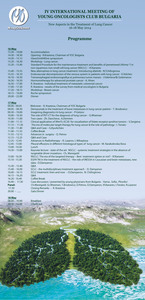Karakolevska Ilova, Marija (2014) Pleural effusion in different histologycal types of lung cancer. In: IV Internationa Meeting of Young Oncologist: New aspects in treatment in lung cancer, 16-18 May 2014, Varna, R. Bulgaria. (Unpublished)
__fileserver_userfiles$_marija.karakolevska_Desktop_Pleural effusion - Bg.pdf
Download (1MB) | Preview
![__fileserver_userfiles$_marija.karakolevska_Desktop_event_2014_program[1].jpg [thumbnail of __fileserver_userfiles$_marija.karakolevska_Desktop_event_2014_program[1].jpg]](https://eprints.ugd.edu.mk/9996/7.hassmallThumbnailVersion/__fileserver_userfiles%24_marija.karakolevska_Desktop_event_2014_program%5B1%5D.jpg)

__fileserver_userfiles$_marija.karakolevska_Desktop_event_2014_program[1].jpg
Download (660kB) | Preview
Abstract
Lung cancer associated with proven malignant pleural effusion is metastatic disease with 5-year survival of 15.9%. Our study of 700 patients with malignant pleural effusions from primary lung cancer showed that one third of patients will develop effusion in the course of the disease with 97.9% of cases in the site of the primary tumor regardless of the histological type and localization. Lung cancer has been shown to have a greater tendency to affect right lung, but lung cancer in the left lung has a greater tendency to develop malignant pleural effusion while each histological type of lung cancer has the same probability to develop a pleural effusion in the course of the disease. The processing of the data showed that primary lung cancer in the course of the disease is mostly present in small pleural effusion 73.5% , and at least with massive pleural effusion 3.2% most likely from squamous cell , but adenocarcinoma has the greatest propensity for large effusion. The large cell carcinoma, even though the rarest histological type of cancer has the propensity developing malignant effusions at any size , regardless of localization. The most common presentation of a pleural effusion is initial presentation and it is usually small effusion, but most likely to develop massive pleural effusion is initially.During the active treatment of lung cancer effusion develops in approximately 5 % but the greater risk is that after radiotherapy can develop effusion of any size. In the course of the disease the effusion persists with even 65 % , and progress in only 6,5%. However, the small effusion is most likely to progress and the large onces at least likely to resolve
| Item Type: | Conference or Workshop Item (Lecture) |
|---|---|
| Uncontrolled Keywords: | peural effusion, lung cancer |
| Subjects: | Medical and Health Sciences > Clinical medicine |
| Divisions: | Faculty of Medical Science |
| Depositing User: | Marija Karakolevska |
| Date Deposited: | 28 May 2014 07:45 |
| Last Modified: | 28 May 2014 07:45 |
| URI: | https://eprints.ugd.edu.mk/id/eprint/9996 |
